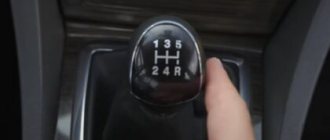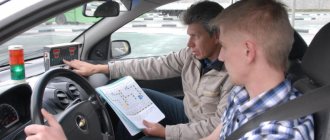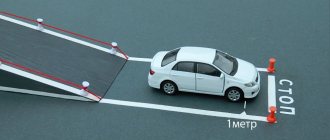What does the document look like?
The front side of the license, which gives the opportunity to drive a car with an automatic and manual transmission, is completely identical. The differences can only be seen from the reverse side. The “AT” mark should be located in the lower left corner when learning to drive a car with an automatic transmission.
This measure allowed students of driving schools to have more comfortable conditions when taking exams, because they no longer need to understand the structure of a manual transmission. But such a measure is still a significant limitation in the resulting category, because now the driver cannot drive a car with a manual transmission.
What is the difference between training for a manual and automatic driving license?
According to Government Decree No. 1097 of October 24, 2014 (as amended on August 14, 2018), cars with manual transmissions used for training and practical exams must be equipped with auxiliary clutch and brake pedals. They must also have a rear-view mirror for the examiner and identification marks “Training Vehicle” (Appendix 3 to the legislative act). Cars with automatic transmission are not equipped with an additional clutch pedal.
The learning process itself on cars with automatic transmission and manual transmission does not differ either in the number of training hours or in the actions practiced. The duration of the course is 2.5-3 months, depending on the conditions of a particular driving school; the same exercises are performed at the autodrome and in the city (turning around, entering an overpass, changing lanes, etc.). The only difference is in the way the vehicle is driven: a car with a manual transmission requires shifting the clutch, but to drive a car with an automatic transmission, only two pedals are used - gas and brake.
Features and capabilities
To be able to drive a car with a manual transmission, the driver will have to retrain and retake the exams. This is because driving with manual controls is much more difficult. The driver will need to understand using the clutch to change speed, learn the gear ratio, and also become comfortable with the need to balance the speed of the vehicle with the engine speed.
Understanding engine operating modes is not easy for everyone. If a driver first learns to drive a car with a manual transmission, then he can easily drive a car with an automatic transmission. The issued licenses are considered universal, since re-examination is not required in this case.
What symbol represents the machine?
The back of the driver's license consists of a table. It lists all groups of vehicles existing in Russia. There are 7 main types of vehicles.
There are also subcategories. There are only 4 of them. Opposite the group for which the cadet is training, the start date of the driver’s license is placed, then the expiration date and a mark.
Read
Which gearbox is more reliable and better: robot, CVT or automatic?
This symbol is represented by two capital letters "AT". The machine is placed only opposite category “B” in column 14. It is located at the bottom of the document under the category table.
| Category | License date (12) | Rights expiration date (11) | Restrictions (12) |
| A | – | – | – |
| A1 | – | – | – |
| B | 15.09.2017 | 15.09.2027 | – |
| B1 | – | – | – |
| C | – | – | – |
| C1 | – | – | – |
14 AT
Having dealt with the differences between documents for a car with an automatic transmission and the place where the driver’s license indicates that the car owner has learned to drive a manual or automatic transmission, the reader will learn about the difficulties of driving a car with a manual transmission.
Categories and subcategories of rights
Now categories marked “automatic or manual” have been expanded with subcategories. There are main categories, which include: “A”, “B”, “C”, “D” or “M”. For driving a vehicle with a trailer, the license has a subcategory with the letter “E” at the end. The main 6 categories are now divided into 16 subcategories. For example, if group “A” allows you to travel on motorcycles, then “A1” only allows you to ride light motorcycles or mopeds with an engine of no more than 125 cc.
IMPORTANT !!! The same story with category “B”. Without adding a unit, vehicles up to 3.5 tons can be controlled. There can be no more than 8 passenger seats. Category “B1” will provide the ability to drive tricycles and quads. Trucks can be driven only if they have category “C”, but if category “C1” is open, then there are restrictions due to which the driver will not be able to drive a vehicle over 7.5 tons.
In general, a unit next to the letter identifier in a category indicates the presence of various types of restrictions. For example, having the “D1” category open, it will be possible to transport passengers by minibuses, the number of seats in which does not exceed 16. Drivers with categories “BE”, “CE”, “C1E”, “D1” or “DE” will be able to drive vehicles of the corresponding category with a trailer whose weight does not exceed 3.5 tons. Mopeds and scooters with an engine capacity of up to 50cc can be driven with the “M” category.
To drive a tram, you will need the category “Tm”, and for a trolleybus – “Tb”. All these categories will be displayed in the rights, but the admission mark will only appear in open positions.
Cost of education
Although training for a manual transmission is much more difficult, the cost of training is much lower. The difference in cost is due to the low cost of such models and cheaper maintenance.
Some schools have the same price for an automatic transmission and a manual one, and the cost of training in a driving school will directly depend on the federal significance of the city. In Moscow or St. Petersburg, driving courses will cost much more than in smaller cities. Each organization providing training services for future drivers calculates the cost of classes in accordance with the adopted regulations. Some companies include the price of lubricants in the cost of training, while others charge for them separately. An important aspect in determining the cost of training is the quality and model of cars provided to students to master the art of driving.
Some drivers have difficulty learning the material taught or need more hours of driving instruction. In this case, they have the opportunity to order additional classes.
What to study in a driving school: automatic or manual
Content
Mechanics: pros and cons
Automatic transmission: pros and cons
Obtaining rights: subtleties and nuances
Tips for choosing a study option
When deciding that it’s time to learn how to drive a car, you should decide in advance: will you master the technique of driving a car with a manual or automatic transmission? This question is quite fundamental: both options have their own characteristics, and they relate not only to driving, but also to obtaining a license. Let's figure out what is better for learning, automatic or manual.
Mechanics: pros and cons
A manual transmission (MT) is the main option for learning to drive (at least in our country). And this choice looks quite logical, because the manual transmission has a whole list of advantages that appear precisely at the training stage:
- Having mastered driving a car with a manual transmission, you can switch to an automatic transmission without much effort. The reverse transition is much more difficult and often leads to an increase in accident rates;
- In the process of mastering the control of a manual transmission, a novice driver develops very useful motor skills. This concerns, first of all, the synchronization of the movements of arms and legs, as in the case of a bicycle: learn once, you will be able to do it all your life;
- Another plus from the mechanics is increased concentration, especially for beginners. Managing the operation of a manual transmission requires the mobilization of intellectual resources, and thanks to this, the novice driver is more prepared for any emergency situations on the roads;
- Finally, the advantage is that the mechanics are learned more slowly. This seems like a disadvantage, but in practice it helps reduce accidents among novice drivers. The reason is simple: as long as the process of driving a car is accompanied by certain difficulties, there is no desire to drive recklessly.
There are also disadvantages to learning to drive a manual transmission:
- learning is difficult, and for some novice car enthusiasts this difficulty seems excessive. That is, anyone can master driving a car with a manual transmission, but many have to spend much more time and money on it;
- Some operations, such as trying to get going or moving uphill, very often become an almost unsolvable problem. In any case, you can’t do this without a competent instructor and self-motivation;
- finally, an inexperienced driver can literally “burn” the clutch due to improper control of the gearbox. This rarely happens, but such a scenario should not be ruled out.
But, despite the disadvantages, the manual transmission is quite easy to master. So, with a responsible approach, it is quite possible to master driving a car with a manual transmission.
Automatic transmission: pros and cons
If previously there was no particular choice, then not so long ago the option of training in a car with an automatic transmission became available in driving courses. This made many happy - automatic transmission is easier to learn and use, so even those who unsuccessfully tried to pass their license several times now have an additional chance.
In principle, this joy is quite understandable: learning to drive a car with an automatic transmission has its advantages. Here they are:
- Automatic transmission is easier to learn, especially in urban environments. By and large, there is no need to make an effort to memorize the algorithms - the machine itself will do everything that is needed;
- when using an automatic transmission, you do not risk making a mistake that will cause the car to stall;
- the driving process itself requires less movement, so you can focus all your attention on the road;
- The machine “handles” slides and other obstacles without additional effort on your part.
All these advantages are quite significant, especially for those who cannot boast of good coordination and high concentration. In other words, almost anyone can learn to drive an automatic car.
Everything would be very good if not for the disadvantages of this solution:
- Using an automatic transmission will not give you the opportunity to master many driving techniques (including braking by shifting gears). And mastery of such techniques can help avoid accidents;
- The automatic transmission has noticeable inertia, and therefore does not always adequately respond to changes in the nature of the vehicle’s movement. In any case, with minimal experience, a manual driver can cope much faster and more efficiently, thereby reducing engine wear.
But the main drawback lies elsewhere - in the process of passing the exam and obtaining a license. It is these nuances that we will examine in the next section.
Obtaining rights: subtleties and nuances
As mentioned above, the main option for learning to drive in the Russian Federation is training in cars with a manual transmission. But since the end of 2013, the possibility of taking a test to drive a car using an automatic transmission has been legislated.
On the one hand, this is a plus: if it doesn’t work out on the manual, you pass it on the automatic and get a license. But there are also nuances:
- firstly, the law allows this, but the mechanism for implementing this law (i.e. the relevant regulations) has not yet been fully developed. Those. there are no guarantees that you will be able to find a driving school that teaches you how to drive a car with an automatic transmission, and there may be purely organizational difficulties in passing the exam;
- even if a driving school is found, the cost of training on an automatic machine will be higher. The reason is obvious: this service is not that common;
- If you have undergone training and passed an automatic transmission test, a corresponding mark will be made on your driver’s license. The holder of such a license will have the right to drive vehicles only with automatic transmission;
- If, after receiving such a license, you want to drive a car with mechanics, you will have to re-take training at a driving school and take an exam. And this costs time and money, and considerable ones at that.
Tips for choosing a study option
The above arguments are enough to choose which gearbox to master driving a car with - automatic or manual. One factor speaks in favor of the machine - simplicity. If you:
- Are you going to drive only an automatic car?
- you have doubts that you can master the mechanics;
- you don’t want to waste time on possible retakes,
then learning to drive with an automatic transmission is just the thing for you.
On the other hand, the option with manual transmission training has many more advantages:
- you acquire the skills to drive more complex vehicles, so you can master a car with automatic transmission without difficulty (if necessary);
- you increase your level of safety by practicing various driving techniques and mobilizing internal resources (coordination, attention);
- after passing the exam, you have a “full” license in your hands, which gives you the opportunity to drive vehicles with any type of transmission;
- you won’t find yourself in a situation where you seem to have a license, but you can’t drive a car (for example, if the rental only has manual cars);
- Finding a high-quality driving school that teaches how to drive a car with a manual transmission is much easier, and the training itself will be cheaper.
Thus, the choice to study mechanics is justified in most cases. But this is not an axiom: in a number of situations you can deviate from this principle and learn to drive a car with an automatic transmission without extra effort.
Differences in exams
The theory of traffic rules remains unchanged, so this exam will be held under the same conditions for all groups. Usually, before starting training, the future driver can choose a car model and type of gearbox, if the driving school has such an opportunity. In small towns, people get a license with a manual transmission much more often, because the range of cars for training there rarely pleases anyone.
The requirements for passing the practical part change quite often, so it is best to find out about them before starting training. The driving test procedure for any type of training is not much different, but there may be some nuances that are best known in advance.
What is the best way to study and what is the best way to pass the exam?
According to the legislation of the Russian Federation, any citizen has the right to choose for himself how to take the driving test. But there are a couple of nuances to this issue. Firstly, the future driver needs to understand that by receiving a license for vehicles with a manual transmission, he will additionally gain access to cars with an automatic or robotic transmission. And this is already a significant advantage.
Secondly, not all driving schools (especially in the provinces) offer the opportunity to choose a car to take the exam. Therefore, if you want to drive a manual transmission, and in your city there will only be training vehicles with automatic transmission, you will have to contact regional centers and undergo training there.
What a future driver needs to know
When learning to use an automatic transmission, you should not drive with a manual transmission. If such a motorist is stopped by representatives of the State Traffic Inspectorate, such an offense will be equated to driving without a license. In this case, the car will be towed to the impound area, and the driver will face a hefty fine and a lot of headaches in freeing his vehicle.
A driver who has never driven before will find it much easier to learn in a car with an automatic transmission than in a car with a manual transmission. Performing complex shifting exercises will not cause him a lot of discomfort. The car will gently obey the driver, without upsetting him with jerks or sudden engine shutdown. This is a huge advantage for beginners. But if such a driver has a car with a manual transmission in his garage, he needs to make a serious decision on the type of training or changing the car. Passing the test when driving with an automatic transmission is quite simplified, because there are no special requirements for the driver.
ATTENTION !!! When training is carried out on a car with a manual transmission, the driver will be able to obtain a universal license that will give him the opportunity to drive any vehicle of this category.
The acquired skills will be useful and applicable in practice. Thanks to this, the car enthusiast will be able to choose his driving style without feeling the limitations that constrain him. Life situations can sometimes change. The driver may have the opportunity to drive only a car with a manual transmission, so you need to be prepared for any turns. Given the same cost of training, it is preferable to choose a mechanical gearbox.
The choice must be made by the driver before the start of training, since in the future he will have to master a more complex option, using additional training hours for this. Experienced drivers recommend learning to drive a car with a manual transmission, but everyone makes the choice for themselves.
The procedure for obtaining the right to an automatic and manual transmission
Attention! Any citizen of the Russian Federation who is 16 years old at the time the license is issued can drive mopeds and motorcycles. Categories A, B, C open after reaching adulthood. A group of licenses to drive a car with a trailer, trucks, buses is issued to students who have turned 21 years old. An educational institution will not accept courses if the student has not reached the required age to obtain a tertiary education in one of the groups.
To become a full-fledged owner of a driver’s license for a car with an automatic transmission or manual transmission, a cadet must:
- learn theoretical information;
- undergo practical training with an instructor;
- pass a medical examination;
- bring the documents that are required;
- successfully pass exams;
- obtain a driving license.
Documents you will need:
- application for the issuance of rights;
- passport identification;
- certificate of registration at the place of residence;
- medical certificate U-89;
- certificate of completion of training in driving programs;
- photo 3x4;
- receipt of payment for exams.
Attention! The cost of a temporary driving permit is 500 rubles, and the state fee for issuing a license costs 2,000 rubles.
The license to drive a vehicle with an automatic or manual transmission is issued directly to those who have completed training. All information about this person is entered into a computer and stored electronically on the traffic police servers.
Cars for training cadets with disabilities are equipped with special equipment. This is done to speed up the production of rights.
Read
Purpose of the Shift Lock release button on an automatic transmission
To obtain a medical certificate, you must visit the following doctors:
- otolaryngologist;
- ophthalmologist. If the future driver has a slight visual impairment, then this will definitely appear on the driver’s license. It, like the symbol “AT”, will be recorded in the fourteenth line. The visually impaired driver symbol is displayed as GCL;
- neurologist;
- do an encephalography;
- donate blood and urine for analysis;
- expert in narcology. If the doctor discovers that the future driver uses even light drugs, then he may be suspended from training for any category of license, not just automatic or manual;
- therapist. He gives an opinion on the degree of suitability to study for a license.
The theoretical part lasts 136 hours, the practical part – 56 hours for passenger vehicles and light-duty trucks.
If the future driver studied independently and wants to take the exams, then he needs to submit an application electronically on the State Services website or to the traffic police. If a cadet nevertheless decides to study at a vehicle driving school, and he does not have enough hours to gain solid skills, then he can turn to the instructors for additional time.











